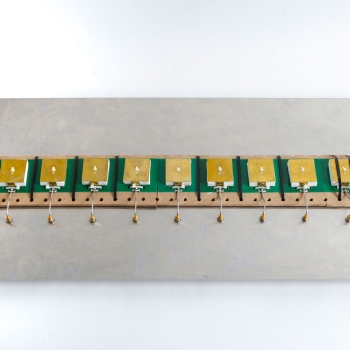Wideband Simultaneous Transmit and Receive (STAR) Antenna with Miniaturized TEM Horn Elements

Antenna systems are critical components in telecommunications, providing radio wave transmissions needed for various forms of communication. With the explosion of data usage and the push toward 5G, there is a growing demand for antennas capable of simultaneously transmitting and receiving (STAR) over wide bandwidths. Traditional antenna designs have struggled to keep pace with these increasing demands. One significant challenge with conventional antenna systems is handling interference caused by the simultaneous transmission and reception of signals. Another setback is the limited bandwidth over which these antennas operate, inhibiting their capacity to deal with a vast range of frequencies. This combination of interference and limited bandwidth can lead to decreased efficiency and quality of the communication system.
Technology Description
The antenna system in question is aimed at facilitating simultaneous transmitting and receiving (STAR) operations over a large bandwidth. Its unique structure incorporates a ring array of TEM horn elements and a centrally situated monocone or bicone antenna. Each of the TEM horn elements includes a unique feature - a capacitive feed. The distinct elements of the ring array are triggered using a phasing scheme aimed at causing signal cancellation at the location of the central element. This ring array can play a dual role, serving either as the transmitting antenna or the receiving antenna. The antenna system stands out due to its unique operative capacity - simultaneous transmit and receive (STAR) in wide bandwidth situations. Thanks to the specialized phasing scheme, signal cancellation is a key feature here, focusing on the central antenna element. This system's flexibility is a significant attribute, with the ring array able to switch roles between transmitting and receiving antenna. This dual functionality renders it distinct in the sphere of such technologies.
Benefits
- Simultaneous multi-band operation supporting higher data transmission speeds.
- Improved signal quality due to the phasing scheme that cancels out interference.
- Increased efficiency due to its dual functionality - acting as both transmitting and receiving antenna.
- Adaptability for various scenarios thanks to its wide operational bandwidth.
- Better performance in high-frequency settings.
Potential Use Cases
- High-speed telecommunication networks including 5G networks.
- Intensive data transmission applications in data centers.
- Aerospace communication systems demanding high-bandwidth operations.
- Advanced military communication systems requiring simultaneous transmission and reception.
- Radio broadcasting stations to improve signal quality.